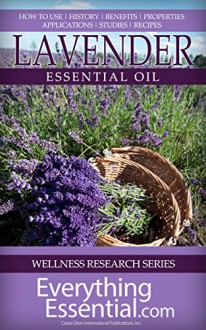Lavender Essential Oil: Uses, Studies, Benefits, Applications & Recipes (Wellness Research Series Book 7)
Lavender, or Lavandula angustifolia, is a gentle oil that’s been traditionally used to heal bruises, cuts and skin irritations, as well as to calm stress and enhance relaxation. The medicinal qualities of lavender were first discovered by the French scientist, René Gattefossé, when he used the oil to help heal a severe burn that he suffered from an explosion in the lab. This highly versatile oil can also be used to help stimulate and energize.
Beyond those applications previously mentioned, additional uses for lavender essential oil include supporting the body’s natural defenses against acne, allergies, sprains, vertigo, bronchitis, asthma, arthritis, earache, headache, athlete’s foot, burns, bruises, chicken pox, colds, flu, sore throat, flatulence, stomach ache, indigestion, diarrhea, colic, cuts, wounds, cystitis, dermatitis, herpes, dysmenorrhea, hypertension, insect bites, insect repellant, insomnia, labor pains, muscle pain, itching, migraine, nausea, oily skin, rheumatism, scabies, psoriasis, scars, sores, stretch marks, and whooping cough. When it comes to the mind, the oil can mentally ground the user, making them feel balanced and relaxed. It also calms frustration and anger, which is helpful when easing stress or anxiety.
Table of Contents:
Benefits of Lavender Essential Oil, Cultivation of Lavender, A History of Lavender, Additional Uses, Chemical Components.
Main Properties of Lavender Essential Oil: Disinfectant & Cleanser, Diuretic, Antioxidant, Antibacterial, Antiviral, Antiseptic, Astringent, Antifungal, Anti-inflammatory, Antidepressant, Sedative.
Common Medicinal Uses: Headaches, Burns, Insect Bites, Anxiety, Stress & Depression, Skin Issues, Nausea & Motion, Sickness, Insomnia, Safety Precautions & Common Applications.
Recipes for Lavender Essential Oil: Pure Supportive Remedies, Anxiety, Allergies, Appetite Stimulant, Arrhythmia, Atherosclerosis, Bites/Stings, Blisters and Boils, Breasts, Burns, Calming, Cancer, Chicken Pox, Cold Sores, Concentration, Convulsions, Cuts, Dandruff, Depression, Detox, Diaper Rash, Diuretic, Dry Lips, Fever, Gangrene, Gas/Flatulence, Giardia, Grief, Hair (Dry, Fragile, or Loss), Hay Fever, Herpes Simplex, Hyperactivity, Impetigo, Inflammation, Insomnia, Itching, Insect Repellant, Jet Lag, Mastitis, Menopause, Menstrual Cramps, Mood Swings, Pain, Physical Stress, Poison Ivy/Oak, Rashes, Rheumatoid Arthritis, Ringworm, Sedative, Seizures, Skin (Dry, Sensitive, Eczema, Psoriasis, etc), Stress, Stretch Marks, Tachycardia, Teeth Grinding, Teething Pain, Thrush, Ticks, Varicose Veins, Vertigo, Worms, Wounds (General), Wrinkles.
Blends:, Acne Serum, Antiseptic Ointment, Allergies, Colds & Flu, Coughs, Eczema, Eye Cream, Head Lice Solution, Healing Salve, Insomnia, Muscle Pain, Pre-Game Sports Rub, Rheumatism, Sinus & Chest Congestion Relief, Shea Butter.
Lavender Essential Oil Studies:
Study 1 – PMS
Study 2 – Pain Relief
Study 3 – Acne & Cancer
Study 4 – Cancer
Study 5 – Diabetes
Study 6 – Neuroprotective Properties
Study 7 – Anxiety
Study 8 – Antifungal Properties
The Ins & Outs of Essential Oils: Where do essential oils come from?, How are essential oils extracted?, Pressing Method, Distillation Method, Solvent Method, Maceration Method, How do you use essential oils?, Topical Administration, Inhalation Therapy, Ingestion.
This is the definitive guide to using Lavender essential oil.
show less

